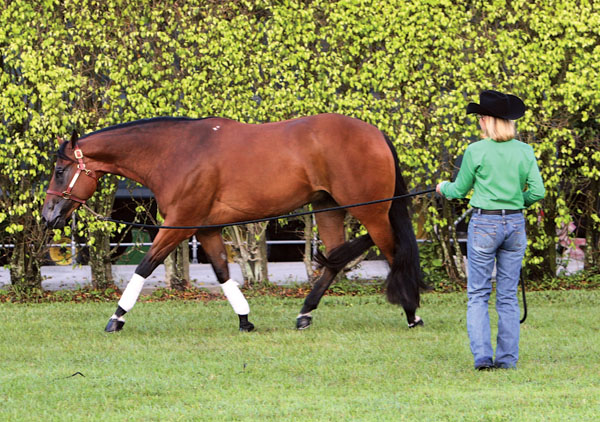Q My 3-year-old Quarter Horse mare has a horrible habit of running away on the longe line. Along with riding, I use a lot of groundwork exercises. She performs everything well, but likes to get away from me on the longe line. If I longe her for more than 5 to 10 minutes, she’ll rear and spin out of the circle so I am directly behind her, and run until she gets the rope away from me. I use a rope halter with 15-foot lead rope and don’t allow her to lean on the rope. This is the only disrespectful act she does, but I don’t want to continue in this rut or have other bad behaviors pop up. Do you have any suggestions on what I need to work on to fix the problem?

Kelli, Minnesota
A You’re right to want to get a handle on this behavior before it endangers you or progresses to other negative behaviors that can turn aggressive. One of the most important things to remember in your situation is that you can’t expect the results out of a young horse that you could out of an aged horse. You must be patient, take your time, and build on small steps toward the larger goal.
A longe line can be a place for a horse to “blow off steam” or play, but she should always come back to the handler and focus on the task at hand when directed to do so. Equally, it’s a way for a handler to get some easy exercise for their horse or to work out freshness before riding, but the handler can’t become distracted and lose focus on the horse. Longeing is a two-way street, just like riding.
Here, I’ll present three common longeing problems that could cause your horse’s response and ways to change how you longe that can alter her attitude.
Check Your Line
Longe-line length can play a large role in your horse’s response, especially if she’s misbehaving or just learning to longe. Letting out too much slack in the line can give your green or ill-mannered horse too much leeway. In a young horse’s circumstances, such as your horse, that gives her more opportunities to test you and to fail at properly responding to your request. If she’s on a too-long line, your horse can become easily distracted; she’s far enough away from you that she knows she can get away with misbehaving.
Instead of letting her all the way out on that 15-foot line, I suggest letting her out no farther than the length of a longe whip—about 6 feet, not including the lash. This way, you know that you can maintain contact with your horse via the whip and your horse isn’t out on her own, far away from you.
When you work on the shorter line length, be sure that you stay with the horse. Let her know that you’re paying attention and she’s not getting away with anything. Once she’s working properly at the short length, start to let more slack out. If you work only on a short line for a long time period, you’ll stress your horse’s legs, feet, and body. Work toward using almost the line’s entire length and working in larger circles.
Time Your Correction
In a best-case scenario, you’ll learn what to watch for when your horse starts to think about stopping and turning away from you. With close, mindful observation, you should start to recognize signs that she’s thinking, “Now I’ve got her.” When you see any inkling that she’s going to try her luck on you, keep her going. Don’t let her stop. The timing of this correction is essential to teaching her that she can’t get away with the behavior.
If she does get her way, start over again. Never end the session with her getting away with poor manners.
Go in With a Plan
Just like with riding, you must approach longeing with a plan. A lot of people let a horse go wild on the longe line or lope on the wrong lead, for example; they don’t have a strategy for what they want to accomplish.
Here’s an example of a solid plan: Beginning at the walk, I’m going to work through all three gaits for five minutes each and then reverse and repeat. It’s fine to let your horse play and get the freshness out, but then it’s time to achieve a goal. The plan will keep you and your horse focused, as well as both of you safe.
Know When to Quit
I’ve seen many handlers longe their horse until she fails—until she breaks gait, stops without a cue, or wheels around and turns away. Knowing when to quit offers a positive reinforcement to your horse. Don’t keep her on the longe line so long that you give her a chance to fail.
Instead, when she gets it right—in this case, a few circles around without turning away from you and without requiring correction—stop and be done until the next session. Then she won’t wind up resenting longeing due to enduring endless sessions and multiple corrections. Instead she’ll have the confidence that she can do it correctly and know that she won’t get worked into the ground in the process. This is especially true for a young horse like yours—keep it simple, short, and to the point. Reward correct response as quickly as possible for future positive results.
Patty Vatterott, Wellington, Florida, is a lifelong horsewoman who now focuses on coaching and educating amateur and youth riders to success in all-around events. Learn more at searidgefarms.com.






